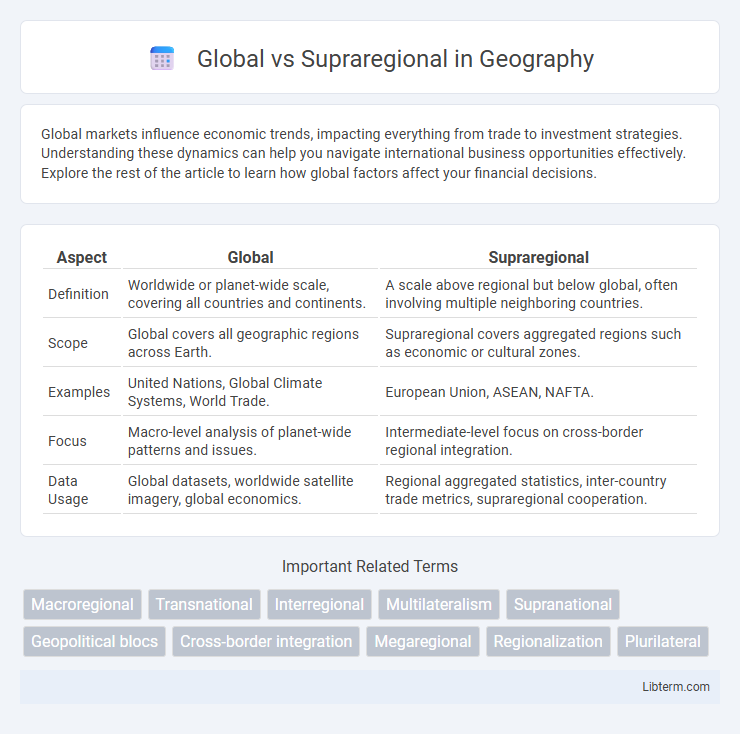Global markets influence economic trends, impacting everything from trade to investment strategies. Understanding these dynamics can help you navigate international business opportunities effectively. Explore the rest of the article to learn how global factors affect your financial decisions.
Table of Comparison
| Aspect | Global | Supraregional |
|---|---|---|
| Definition | Worldwide or planet-wide scale, covering all countries and continents. | A scale above regional but below global, often involving multiple neighboring countries. |
| Scope | Global covers all geographic regions across Earth. | Supraregional covers aggregated regions such as economic or cultural zones. |
| Examples | United Nations, Global Climate Systems, World Trade. | European Union, ASEAN, NAFTA. |
| Focus | Macro-level analysis of planet-wide patterns and issues. | Intermediate-level focus on cross-border regional integration. |
| Data Usage | Global datasets, worldwide satellite imagery, global economics. | Regional aggregated statistics, inter-country trade metrics, supraregional cooperation. |
Defining Global and Supraregional Concepts
Global concepts encompass worldwide systems, integrating diverse regions through international connections and universal frameworks. Supraregional concepts refer to entities that span multiple regions but do not cover the entire globe, often involving large transnational areas with shared economic, cultural, or political characteristics. Defining these concepts requires analyzing the scale, scope, and interconnectivity of areas beyond local or national boundaries.
Historical Evolution of Global and Supraregional Dynamics
The historical evolution of global and supraregional dynamics traces back to early trade routes like the Silk Road, which facilitated interactions beyond regional borders and laid the groundwork for interconnected economies. The rise of empires and colonial expansions between the 15th and 19th centuries accelerated supraregional networks by integrating distant territories under centralized control. In the modern era, globalization intensified through technological advancements such as the steam engine, telegraph, and internet, transforming supraregional connections into a complex global system of economic, political, and cultural exchange.
Key Differences Between Global and Supraregional Scales
Global scale represents the entire Earth, incorporating all countries and ecosystems, while supraregional scale covers multiple regions within larger geographical areas, often spanning several countries or states. Global analysis addresses worldwide trends and phenomena like climate change or global trade networks, whereas supraregional studies focus on cross-regional interactions and shared issues such as regional economic integration or transboundary environmental management. The key difference lies in the scope and granularity, with global scale offering a holistic planetary perspective and supraregional scale providing detailed insights into interactions across contiguous or functionally linked regions.
Examples of Global vs Supraregional Organizations
Global organizations like the United Nations and World Health Organization operate worldwide, addressing issues that affect multiple countries across continents. Supraregional organizations such as the European Union and the Association of Southeast Asian Nations focus on specific regions, facilitating economic integration and political cooperation among member states. These differences highlight the scope and scale of collaboration, with global entities targeting broad international challenges and supraregional bodies concentrating on regional development and stability.
Economic Impacts: Globalization vs Supraregional Integration
Globalization drives economic growth by expanding markets, increasing foreign direct investment, and promoting technological transfer across multiple continents. Supraregional integration enhances economic efficiency within specific geographic clusters, such as the European Union or ASEAN, by standardizing regulations and reducing trade barriers among member states. Both processes foster economic development but differ in scale, with globalization offering broader market access while supraregional efforts focus on deeper cooperation and policy alignment within a particular region.
Political Implications of Global and Supraregional Cooperation
Global cooperation shapes international policies by addressing worldwide challenges like climate change and security, influencing power dynamics among nation-states. Supraregional cooperation fosters political integration among neighboring countries, enhancing regional stability and collective decision-making. These frameworks impact sovereignty, requiring states to balance national interests with shared governance obligations.
Cultural Exchange: Global vs Supraregional Perspectives
Global cultural exchange encompasses the widespread diffusion of traditions, languages, and customs across continents, fostering diverse intercultural interactions and widespread hybridization. Supraregional perspectives emphasize exchanges within adjacent or connected regions, promoting shared cultural practices and regional identity formation without the extensive globalization impact. This localized focus often results in more cohesive cultural integration and preservation of unique regional characteristics while contributing to broader global diversity.
Challenges Faced at Global and Supraregional Levels
Global and supraregional governance face distinct challenges related to scale and coordination complexity. At the global level, issues include navigating diverse legal systems, managing conflicting national interests, and addressing widespread disparities in resources and development. Supraregional entities struggle with balancing national sovereignty against collective goals, harmonizing policies across member states, and ensuring equitable participation and enforcement.
Case Studies: Successful Supraregional Initiatives
Successful supraregional initiatives demonstrate effective collaboration beyond national borders, leveraging shared resources and expertise to address common challenges. Case studies include the European Union's Transnational Cooperation Programmes, which foster innovation and economic development across multiple countries. These initiatives illustrate how supraregional frameworks enhance regional integration and competitive advantage compared to broader global efforts.
Future Trends in Global and Supraregional Relations
Future trends in global and supraregional relations emphasize increasing interdependence through digital innovation, climate cooperation, and economic integration. Supraregional frameworks, such as the European Union and ASEAN, are poised to strengthen collective policy-making and security measures, enhancing resilience against global challenges. The rise of multipolarity will drive more complex diplomacy, with regional blocs balancing global powers to ensure sustainable development and geopolitical stability.
Global Infographic

 libterm.com
libterm.com